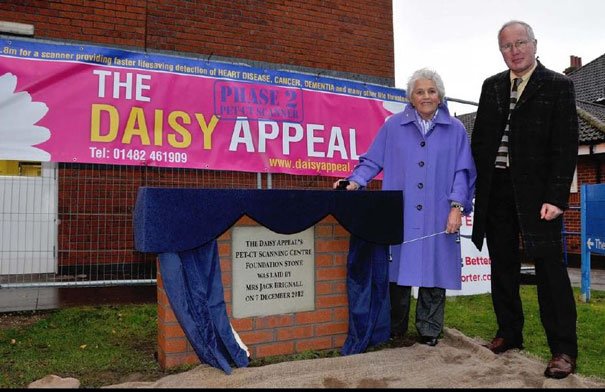
The Daisy Launch hosted by Professor Nick Stafford at Castle Hill hospital on 7th December was a huge success. The launch marked the laying of the foundation stone for a new state of the art PET/CT scanning centre.
Invited guests included The Lord Mayor of Hull, Chief Executive of Hull and East Yorkshire Trust Phil Morley and Assem Allam amongst others.
Mrs Beryl Brignall, wife of Mr Jack Brignall unveiled the stone. The foundation stone marked Mr Brignall’s name in honour of the support and time he dedicated to The Daisy Appeal.
The Daisy Appeal was founded ten years ago by Professor Nick Stafford, Head and Neck Surgeon and Theme Leader for Health and Well Being for the University of Hull. In 2008 Phase 1 of the charity was launched presenting the Daisy Building.
The Daisy Building has seen successful grants to the sum of £4,000,000 and includes plenty of externally funded research work. It is home to Hull York Medical School (HYMS) which attracts budding new scientists to the area and allows medical research teaching.
Prof. Stafford says, “In a time of recession the NHS is cash strapped, there are things that the medical workforce would like in terms of kit and facilities but can’t afford. The intention of the Daisy Appeal will help provide these things as long as they tie in with the promotion of the R&D agenda”.
Now four years on we are beginning the journey of Phase 2 – the PET/CT Scanner.
The PET/CT scanner will compliment the current imaging devices while offering a new diagnostic technique. Cardiac and neurological diseases will be more easily detected as well as cancers. This will be a breakthrough for the future of diagnostics and will eventually become a leading scanning modality. The scanner will be ideally placed at Castle Hill for the main intention of it being near to essential facilities such as the Queens Centre and the Cardiac Centre.
“The aim of the scanner is that once opened it will be available 24/7 which is different from what existing services offer at the moment. It will also allow patients to have other types of scans which are crucial for developing research in the future.”
The Daisy Appeal works closely with The University of Hull and Prof. Stafford hopes that Hull will become a leading reference centre for research in the UK.
An accompaniment to the PET/CT Scanner is the cyclotron. A table top cyclotron produces its own radio-isotopes such as carbon-11. Carbon-11 is one of the necessary radio-isotopes that detects neurological and cardiac diseases and cancers. The half-life of this is only fifteen minutes so having the cyclotron nearby to the scanner is essential.
There is a cyclotron currently being installed at The University of Hull. Research and development is currently underway into diagnostic markers and medical application will be seen in the near future.
There is continual fundraising and The Daisy Appeal would be delighted if this continued into the future. The building of the PET/CT building will commence on 7th January 2013 and looks to be complete by Christmas 2013. Prof. Stafford asks if anyone has any ideas of future fundraising ventures to get in touch!
By Natassha Gray


